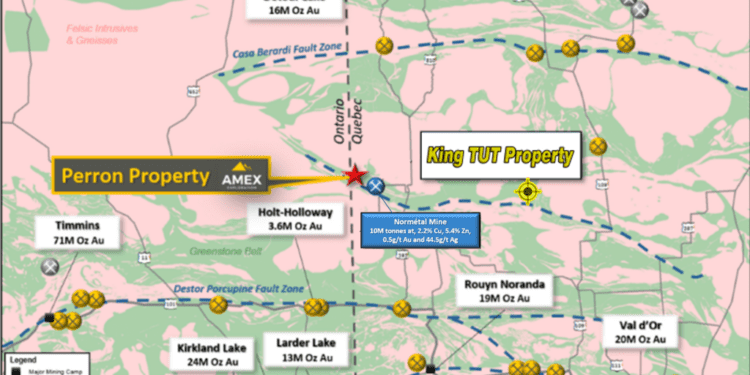4000m Drilling Programme In Abitibi Gold Belt
BMEX Gold Inc.(TSXV:BMEX) has commenced a 4000m, 25 hole, diamond drill programme on its King Tut property in Quebec, Canada.
The first portion of Phase 1 of exploration will consist of 2000m of drilling in November 2020 and focus on testing the Authier East target and refine the initial geological models developed by the BMEX technical team.
The King Tut property is located in a region identified as the Abitibi Gold Belt, along the Chicobi regional fault line. This region of Canada extends from Wawa, Ontario to Val-d’Or, Quebec,
It is characterised by the mineral-rich Abitibi Greenstone Belt and is an established gold mining district having produced over 100 mines, and 170 million ounces of gold since 1901.
VP Exploration, Martin Demers, said the company’s exploration plans are motivated by the recent drilling of high grade gold intercepts on the Perron deposit by Amex Exploration, located approximately 60 km away on the same fault line and demonstrating similar geological contexts.
Interpretation of the geophysical data and previous assessment reports filed at the Province of Quebec define a zone identified as “Authier East Target.” This formation is located at a structural intersection where strike slip faults cut obliquely the regional shear zone.
BMEX is targeting this structural zone first, after having conducted an in-depth analysis of an extensive amount of historical data. Other similar intersections have been interpreted on the property with a one km radius around the Authier East target and BMEX will eventually qualify and test these additional targets.
“Owing to efficiency of the permitting and consultation process, and easy access to the property, we were able to hire local drilling contractors and mobilise equipment and personnel to the site to begin our exploration program quickly and efficiently,” Mr Demers said.
“Our drill programme will focus on the area of the King Tut property where there have been historical results to enhance our confidence in the historical data while obtaining new information to develop this target “
Mr Demers said historical data analysis has revealed that 66 holes were drilled on the property since 1945.
The gold mineralisation has been traced inside a 400m thick sequence of gold bearing rocks previously shallowly drilled to a depth of 300m. Laterally, mineralisation extends over more than 500m.
Visually, the mineralisation corresponds to a network of gold bearing quartz veins hosted in a major steeply dipping shear zone principally developed close to volcano-sedimentary contacts.












